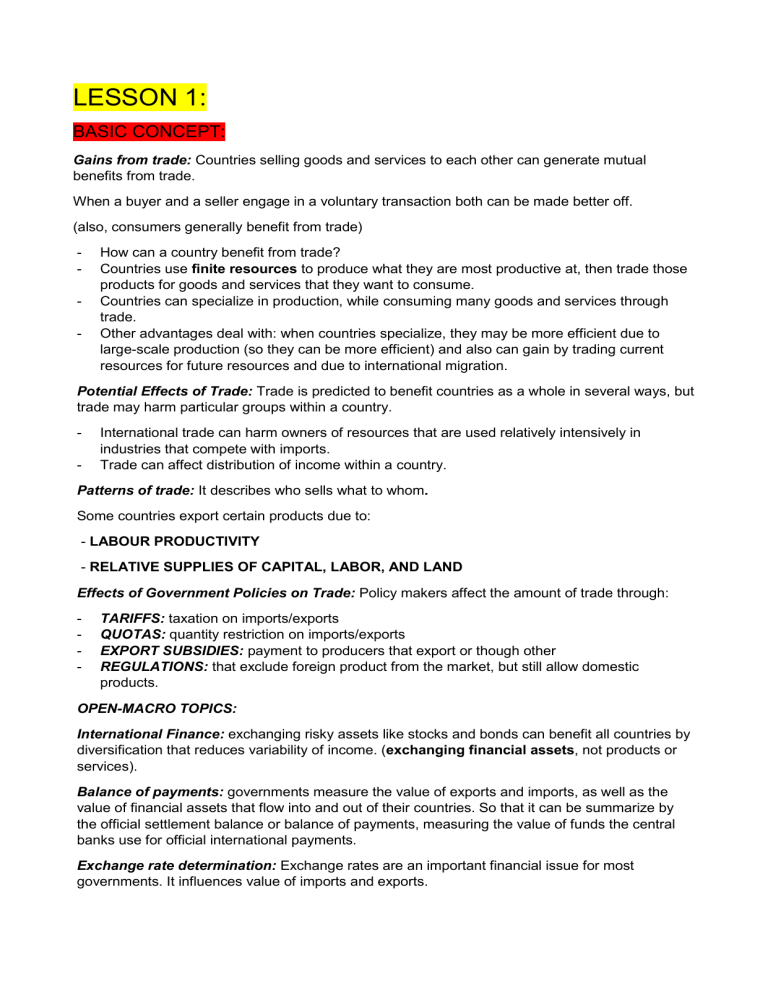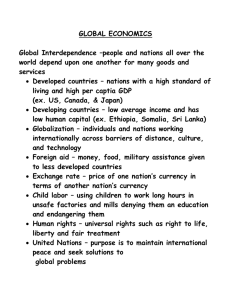
LESSON 1: BASIC CONCEPT: Gains from trade: Countries selling goods and services to each other can generate mutual benefits from trade. When a buyer and a seller engage in a voluntary transaction both can be made better off. (also, consumers generally benefit from trade) - How can a country benefit from trade? Countries use finite resources to produce what they are most productive at, then trade those products for goods and services that they want to consume. Countries can specialize in production, while consuming many goods and services through trade. Other advantages deal with: when countries specialize, they may be more efficient due to large-scale production (so they can be more efficient) and also can gain by trading current resources for future resources and due to international migration. Potential Effects of Trade: Trade is predicted to benefit countries as a whole in several ways, but trade may harm particular groups within a country. - International trade can harm owners of resources that are used relatively intensively in industries that compete with imports. Trade can affect distribution of income within a country. Patterns of trade: It describes who sells what to whom. Some countries export certain products due to: - LABOUR PRODUCTIVITY - RELATIVE SUPPLIES OF CAPITAL, LABOR, AND LAND Effects of Government Policies on Trade: Policy makers affect the amount of trade through: - TARIFFS: taxation on imports/exports QUOTAS: quantity restriction on imports/exports EXPORT SUBSIDIES: payment to producers that export or though other REGULATIONS: that exclude foreign product from the market, but still allow domestic products. OPEN-MACRO TOPICS: International Finance: exchanging risky assets like stocks and bonds can benefit all countries by diversification that reduces variability of income. (exchanging financial assets, not products or services). Balance of payments: governments measure the value of exports and imports, as well as the value of financial assets that flow into and out of their countries. So that it can be summarize by the official settlement balance or balance of payments, measuring the value of funds the central banks use for official international payments. Exchange rate determination: Exchange rates are an important financial issue for most governments. It influences value of imports and exports. International Policy Coordination: one country’s economic policies can affect other ones, leading to the need for policy coordination. International Trade Versus Finance: - International trade focuses on transactions involving movement of goods and services across nations. - International Trade Theory (2-8), and policy (9-12), - International monetary theory (13-18) and policy (19-22) GRAVITY MODEL: The gravity model is basically the workhorse of empirical trade research and not only used in trade but also on any kind of flow of factors can be emperor anymore that with the gravity model. So, it has been the right for migration flows, but also capital flows and trade. Three of the top 15 U.S. trading partners are European nations: Germany, the United Kingdom, and France. WHY DOES THE UNITED STATES TRADE MORE HEAVILY WITH THESE THREE EUROPEAN COUNTRIES THAN WITH OTHERS? - These are the three largest European economies. That is, they have the highest values of gross domestic product (GDP), which measures the total value of all goods and services produced in an economy. There is a strong empirical relationship between the size of a country’s economy and the volume of both its imports and its exports. HOW DO YOU THINK A COUNTRY SIZE INFLUENCES TRADE BETWEEN COUNTRIES? - Obviously, a big country, a bigger demand, trade more with each other. So, when we are talking about size of the economy, what we mean really is size of production on economic activity on the land, you added off the economy, which can be very well measured with GDP. WHAT CAN WE INFER? - Size of an economy is directly related to the volume of imports and exports. Larger economies produce more goods and services, so they have more to sell in export market. Larger economies generate more income from the goods and services sold, so they are able to buy more imports. WHY IS IT CALLED GRAVITY MODEL? It is more closely to ship things between countries so their historical reasons off than closer countries straight more. But the further away you are, the more closely it is to trade. But also, you know, the further away the countries are the more difficult to trade. Size and distance are the most important influencing factors. Anomalies: Netherlands, Belgium, and Ireland trade much more with the U.SA. than predicted by a gravity model because Ireland has strong culture (common language), Netherlands and Belgium are closer instead. (is a matter of distance) So, “Impediments to trade” are: - Distance between markets influences transportation costs and therefore cost of imports and exports. - Cultural affinity usually lead to strong economies ties. - Geography: ocean harbours and a lack of mountain barriers make transportation and trade easier. Also: - Multinational corporation and many transactions between their divisions. - Borders: crossing borders involves formalities that take time, often different currencies need to be exchanged and so monetary costs like tariffs reduce trade. Borders increases the cost and time needed to trade - Trade agreements and Tariffs: reduce the formalities and tariffs needed to cross borders and therefore to increase trade. “EX: The U.S does markedly more trade with its neighbours than it does with European economies of the same size due to the NAFTA agreement”, which ensures that most goods shipped among the three countries are not subject to tariffs or other barriers to international trade. WHY DOES THE UNITED STATES DO SO MUCH MORE TRADE WITH ITS NORTH AMERICAN NEIGHBORS THAN WITH ITS EUROPEAN PARTNERS? - One main reason is the simple fact that Canada and Mexico are much closer. All estimated gravity models show a strong negative effect of distance on international trade: typical estimates say that a 1 percent increase in the distance between two countries is associated with a fall of 0.7 to 1 percent in the trade between those countries. This drop partly reflects increased costs of transporting goods and services. Economists also believe that less tangible factors play a crucial role: Trade tends to be intense when countries have close personal contact, and this contact tends to diminish when distances are large. For example, it’s easy for a U.S. sales representative to pay a quick visit to Toronto, but it’s a much bigger project for that representative to go to Paris.



